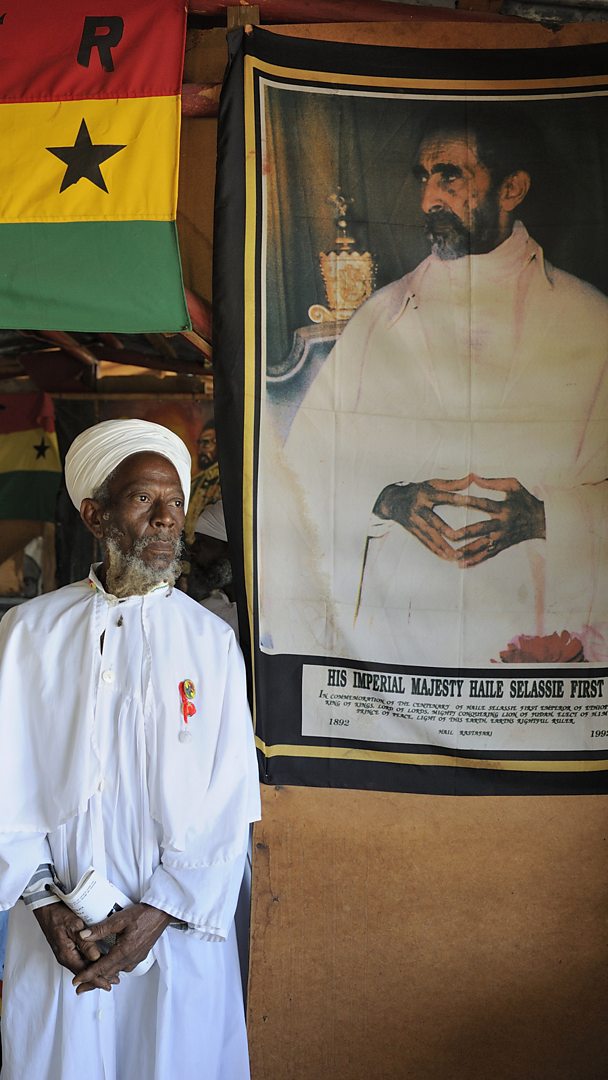Did you know who was The Rastafarian messiah???? **7 THINGS** you probably don't know about Haile Selasie, Former Emperor of Ethiopia!!!
1. King, god or Redeemer?
Think about Rastafari and you’ll immediately conjure images of the charismatic reggae master Bob Marley and his headful of swirling dreadlocks. Marley is certainly a Rastafari icon, but there is another man at the heart of the Jamaican movement.He is Ras Tafari: that was the birth name of Ethiopia's 225th and last emperor, who was born on 23 July 1892, and took the regal name Haile Selassie I when he was crowned. For Rastas, he is God (or Jah) incarnate - the redeeming messiah.
Nearly 8,000 miles separate Addis Ababa, the capital of Ethiopia, and Kingston, Jamaica, but a link between them was forged by a number of poor black Jamaicans who believed Ras Tafari’s coronation was the fulfillment of a prophecy and that he was their redeemer, the messiah written of in the Bible’s Book of Revelation: “King of Kings, Lord of lords”.
They believed he would arrange for a deliverance, which, as they saw it, involved a miraculous transformation. They would be spirited away from their lives of poverty in the Caribbean and relocated in Africa, the land of their ancestors and their spiritual epicentre.
Tafari was a son of a chief adviser to Emperor Menelik IIl, one of Ethiopia's greatest rulers. Since childhood, his intelligence impressed the Emperor, who facilitated his political career. When in 1930 Menelik II's daughter Empress Zauditu died, Tafari was crowned emperor.
Haile Selassie's coronation was a lavish event attended by royals and representatives from all over the world. The New York Times reported on the expensive gifts received by the attendees and speculated that the celebrations may have cost more than $3,000,000. Time Magazine dedicated its iconic cover to the Emperor: it was a world sensation.
Soon after his coronation, Haile Selassie gave Ethiopia its first written constitution, which greatly restricted the powers of Parliament. Effectively, he was the Ethiopian government. Succession to the throne was restricted to his descendants and, the constitution stated, "the person of the Emperor is sacred, his dignity inviolable, and his power indisputable."
But in Jamaica, Haile Selassie was becoming more than the name of a powerful emperor.

Marcus Garvey in 1924
2. From RasTafari to Haile Selassie
Emperor Selassie uncovers a statue in his honour at his coronation in Addis Ababa. This video has no sound.Tafari was a son of a chief adviser to Emperor Menelik IIl, one of Ethiopia's greatest rulers. Since childhood, his intelligence impressed the Emperor, who facilitated his political career. When in 1930 Menelik II's daughter Empress Zauditu died, Tafari was crowned emperor.
Haile Selassie's coronation was a lavish event attended by royals and representatives from all over the world. The New York Times reported on the expensive gifts received by the attendees and speculated that the celebrations may have cost more than $3,000,000. Time Magazine dedicated its iconic cover to the Emperor: it was a world sensation.
Soon after his coronation, Haile Selassie gave Ethiopia its first written constitution, which greatly restricted the powers of Parliament. Effectively, he was the Ethiopian government. Succession to the throne was restricted to his descendants and, the constitution stated, "the person of the Emperor is sacred, his dignity inviolable, and his power indisputable."
But in Jamaica, Haile Selassie was becoming more than the name of a powerful emperor.
3. Marcus Garvey and the vision of Africa

“Look to Africa when a black king shall be crowned, for the day of deliverance is near.” This was the prophecy that started it all.
The prophecy was Marcus Garvey’s. Garvey was a Jamaican activist who campaigned for political and social change on an island that had been an important centre for slavery. After the slave trade was abolished in 1833 and Abraham Lincoln's Emancipation Proclamation freed "all persons held as slaves", life did not improve dramatically for ex-slaves, their children and successive generations of black people.
It's unclear whether the “black king” Marcus Garvey had referred to was an actual person; more likely, he meant it as a symbolic figure. But, when news of Haile Selassie's coronation in 1930 reached Jamaica, many of Garvey’s followers made what seemed to them a logical link. Ras Tafari was the king, and so the day of deliverance was imminent. That meant they should prepare themselves for an exodus to Africa.
Although Marcus Garvey was never actually a Rastafarian, he is considered to be one of the religion's prophets, as his ideals heavily shaped the Rastafarian philosophy.
Only a few years after Haile Selassie's coronation, Ethiopia became involved in a terrible war.
The prophecy was Marcus Garvey’s. Garvey was a Jamaican activist who campaigned for political and social change on an island that had been an important centre for slavery. After the slave trade was abolished in 1833 and Abraham Lincoln's Emancipation Proclamation freed "all persons held as slaves", life did not improve dramatically for ex-slaves, their children and successive generations of black people.
It's unclear whether the “black king” Marcus Garvey had referred to was an actual person; more likely, he meant it as a symbolic figure. But, when news of Haile Selassie's coronation in 1930 reached Jamaica, many of Garvey’s followers made what seemed to them a logical link. Ras Tafari was the king, and so the day of deliverance was imminent. That meant they should prepare themselves for an exodus to Africa.
Although Marcus Garvey was never actually a Rastafarian, he is considered to be one of the religion's prophets, as his ideals heavily shaped the Rastafarian philosophy.
Only a few years after Haile Selassie's coronation, Ethiopia became involved in a terrible war.
4. War in Ethiopia
Top image: An Abyssinian soldier operates an anti-aircraft gun during the Italian invasion in 1936. Bottom image: Emperor Selassie arrives in Jamaica in 1966.
In 1935, Benito Mussolini's troops invaded Ethiopia and, in 1936, Haile Selassie fled in exile with his family. That year, he delivered a famous speech to the League of Nations in Geneva, appealing for help to fight the invaders.
Although during that time he tried to raise awareness for the Ethiopian cause in Europe, Selassie spent five years away from his country. He stayed mainly at Bath's Fairfield House, but he also briefly stayed in London - a time that is commemorated by a bust in the city's Cannizaro Park - and in Malvern, in Worcestershire. Marcus Garvey heavily criticised him for leaving his own countrymen at the mercy of Italy. Haile Selassie reinstituted his powers as emperor in 1941, with support from Britain.
Visit to Jamaica
On April 21, 1966, Haile Selassie visited Jamaica. This was 36-years after his coronation and the enthusiasm of Rastas was undimmed. There was now a new generation of Rastas, many of whom still harboured the vision of an African exodus.
Haile Selassie was overwhelmed by the rapturous reception.
He did nothing to dispel thoughts of his divine status. By this time, Garvey had died and his criticism of Haile Selassie forgotten in Jamaica. But around the world, the jury was not unanimous. Although he wanted to project the image of a progressive emperor, he faced accusations of being a greedy dictator.
Among the rapturous crowds who turned out to honour their redeemer was the wife of a 21-year-old Jamaican musician. He had just formed a band called the Wailers and his name was Robert Nesta Marley.

Source: BBC
Comment & Share this story!!!
In 1935, Benito Mussolini's troops invaded Ethiopia and, in 1936, Haile Selassie fled in exile with his family. That year, he delivered a famous speech to the League of Nations in Geneva, appealing for help to fight the invaders.
Although during that time he tried to raise awareness for the Ethiopian cause in Europe, Selassie spent five years away from his country. He stayed mainly at Bath's Fairfield House, but he also briefly stayed in London - a time that is commemorated by a bust in the city's Cannizaro Park - and in Malvern, in Worcestershire. Marcus Garvey heavily criticised him for leaving his own countrymen at the mercy of Italy. Haile Selassie reinstituted his powers as emperor in 1941, with support from Britain.
Visit to Jamaica
On April 21, 1966, Haile Selassie visited Jamaica. This was 36-years after his coronation and the enthusiasm of Rastas was undimmed. There was now a new generation of Rastas, many of whom still harboured the vision of an African exodus.
Haile Selassie was overwhelmed by the rapturous reception.
He did nothing to dispel thoughts of his divine status. By this time, Garvey had died and his criticism of Haile Selassie forgotten in Jamaica. But around the world, the jury was not unanimous. Although he wanted to project the image of a progressive emperor, he faced accusations of being a greedy dictator.
Among the rapturous crowds who turned out to honour their redeemer was the wife of a 21-year-old Jamaican musician. He had just formed a band called the Wailers and his name was Robert Nesta Marley.
5.The Rastaman cometh
6.I and I

A Rastafarian stands next to a banner of Haile Selassie in Kingston, Jamaica.
7.How does Haile Selassie live in music?
Many musicians wrote songs inspired by Selassie. Bob Marley's song War, is almost verbatim from his speech before the United Nations in 1963.Source: BBC
Comment & Share this story!!!
ZeroDegree.
Did you know who was The Rastafarian messiah???? **7 THINGS** you probably don't know about Haile Selasie, Former Emperor of Ethiopia!!!
 Reviewed by Zero Degree
on
11/30/2015 04:50:00 PM
Rating:
Reviewed by Zero Degree
on
11/30/2015 04:50:00 PM
Rating:
 Reviewed by Zero Degree
on
11/30/2015 04:50:00 PM
Rating:
Reviewed by Zero Degree
on
11/30/2015 04:50:00 PM
Rating:










